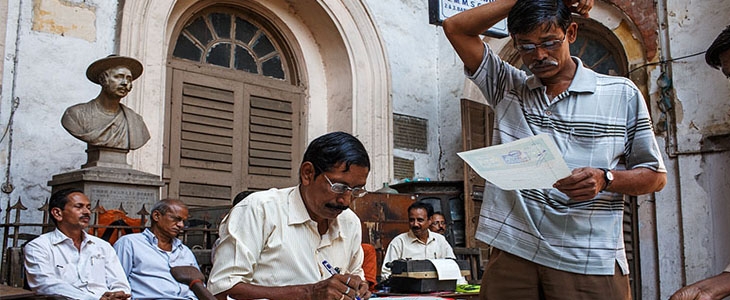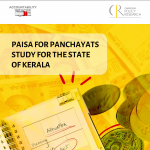
The ABC of Indian Bureaucracy- An Epilogue
4 September 2017
Over the course of the last few weeks, through an alphabet series on the unique vocabulary of the Indian bureaucracy, we tried to present a satirical take on what it is that makes the Indian bureaucracy the formidable labyrinth that it appears to be to the common person. A language entirely of its own has in fact made the difference between the proverbial “insider” and “outsider” of the system much starker than it already was.
Reflecting on the numerous ways in which the same language is transmitted, absorbed and interpreted in the bureaucratic cog wheels makes one wonder about what is it that allows the perpetuation of such practices? While it is not untrue that each system develops certain codes and systems of meaning-making that are largely internal, for the bureaucracy this meaning-making has implications both in terms of how rules are understood as well as applied.
The subtext of the satire throughout this series was a commentary on the many systemic, long-pending and very difficult issues that plague the bureaucracy, which makes “normal” modes of working nearly impossible. From the rigid insistence on paperwork, mired in enduring red-tape; to the ever-present lack of staff, resources, funding; the strict hierarchies, the complex (perhaps even outmoded) systems of fixing responsibility-accountability; the use of fear and punishment as incentives for performance; and perplexingly the perseverance with which the bureaucracy appears to hold on to norms of bygone eras- each of these tendencies appear to give the bureaucracy a distinct character which is unique to itself.
A logic of its own
In fact, unlike governments, parties, corporates and even other private organisations, all of which are heavily dependent on, and can be steered in different directions by the leadership and management of different entities, the bureaucracy comes across as one of those unique systems- almost like markets, which have a logic of their own, shaped almost by an invisible hand. Much like the incomprehensible markets, the bureaucracy also appears to work on its own terms, no matter what one does from the inside or outside.
What we need first is an acknowledgement of the significant (if not most important) role that the bureaucracy plays any kind of “good governance”, of realising its needs, its difficulties.
The trait of the bureaucracy, of changing people to suit itself, rather than be modified through them and their actions, has resulted in ensuring that the system remains as it is no matter what happens outside. There appears to be an implicit understanding within the system that no matter who else comes or goes- governments, leaders, parties or policies, the bureaucracy alone is what will stay intact. This understanding, of governments being “replaceable” is at times so deep rooted within the mindset of those inside babudom, that it makes the concept of accountability to governments extremely complex. The idea of a “committed bureaucracy”- one that owes allegiance to the government (rather than the public) has also seen its fair share of debate over the decades, causing in fact the bureaucracy to be answerable more to itself than anyone else at the end of the day.
Bureaucracy and Governance
Nonetheless, no matter how such knowledge is absorbed by the bureaucratic system- knowing that it alone is what will remain intact once everything transient has gone, places the bureaucracy in a rather complex but interesting position within larger systems of governance. Given the pivotal role that the bureaucrats play in effecting everything- from policy design to policy implementation, being the mainstay of it all, a true transformation can only be achieved in any capacity once the bureaucracy adapts it and takes up the mantle of affecting change.
This unfortunately has not proven to be the case in general in a system which, unreformed from within, continues to be caught up in a colonial legacy and time warp of a bygone era- things move slowly here, at their own pace, and the long winding “due processes”, paying homage to hierarchies are considered more important than a focus on efficiency and/or speedy results. Many a times thus, the pulls and pushes of the system make it impossible for well-meaning interventions to be suitably adopted even when there may be the will to do so. This, coupled with the genuine systemic hurdles and extreme shortages that a chronically understaffed and over-pressurized system faces makes the task even harder- it is a wonder that the Indian bureaucracy has endured the way it has until now in such conditions!
But this is not to say that all hope is lost. The fact that the bureaucracy has endured in its ways is not to suggest that it has to, or must continue to do so. What we need first is an acknowledgement of the significant (if not most important) role that the bureaucracy plays any kind of “good governance”, of realising its needs, its difficulties, and its issues, and focusing on resolving those before expecting any magical turnaround through policies or reform measures which may appear great on paper but come close to nothing on fruition.
The bureaucracy is the backbone of this system, and it needs adequate care, so that its existing vocabulary, now rusty and ancient, can be revitalised in a way that effectively reflects the aspirations of a country longing for change. Any dreams of a “New India” rest surely but squarely on the collective efforts of all institutions of governance, and the embeddedness of such changes can only begin by strengthening the institution that perhaps bears the biggest brunt of it all- the bureaucracy.
Till such time as this happens, the current vocabulary would have to do- here’s hoping that this series helped explain some of those terms to you, albeit through a comic take.
Take a look at the blog series here and to share the blog series, click here.





